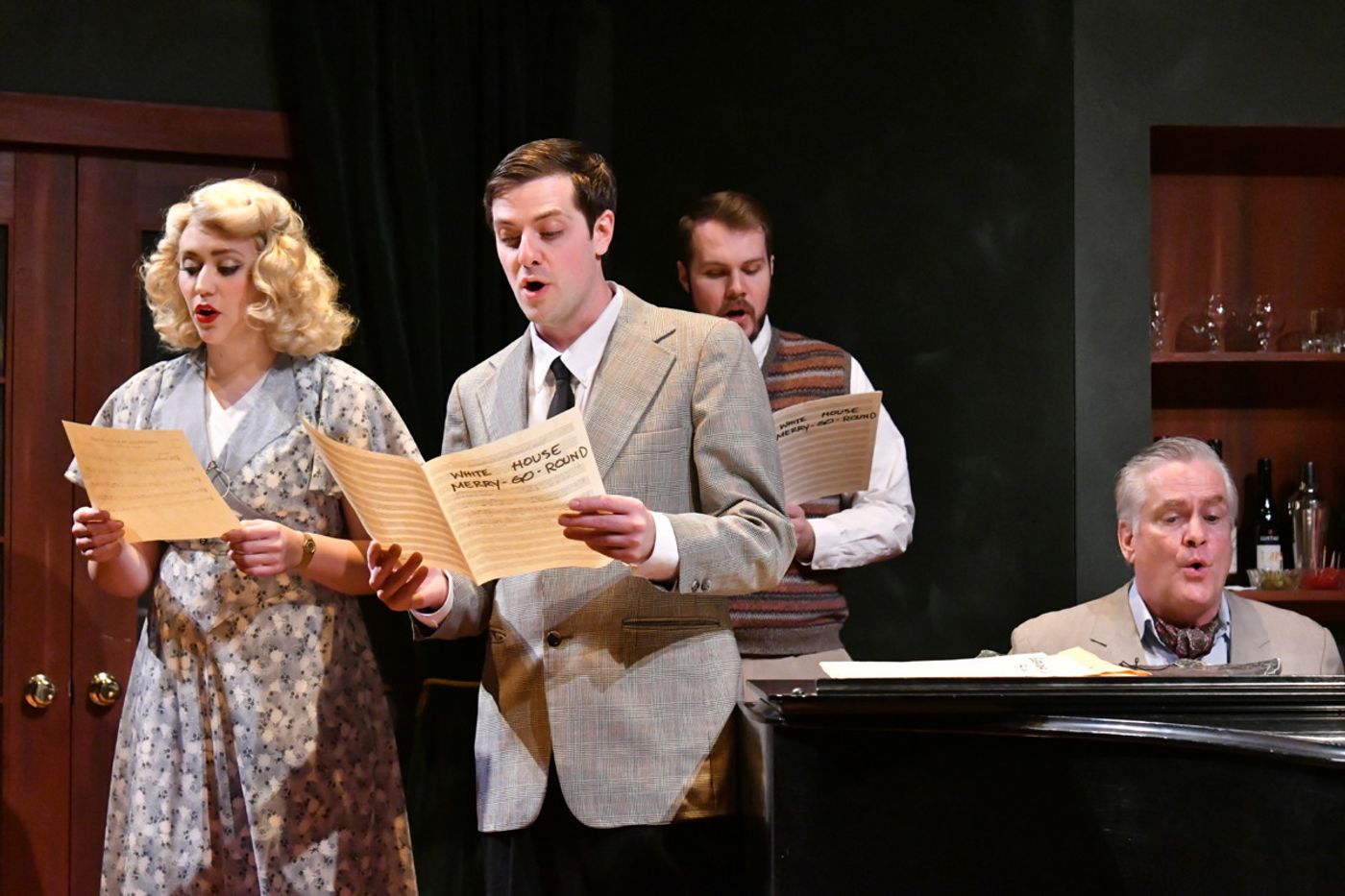Review: THE MUSICAL COMEDY MURDERS OF 1940 at The Grand Theatre
 THE MUSICAL COMEDY MURDERS OF 1940 at The Grand Theatre's Backstage series is "simply divoon," if "divine" is mispronounced with disdain by the show's Broadway producer character, Marjorie Baverstock.
THE MUSICAL COMEDY MURDERS OF 1940 at The Grand Theatre's Backstage series is "simply divoon," if "divine" is mispronounced with disdain by the show's Broadway producer character, Marjorie Baverstock.
But it isn't entirely a solvable murder mystery and is barely a musical.
One of the songs written for the backers' audition of an in-development musical (from within the play) is "Every One Can Do Bettter."
The creative team of a recent Broadway flop, in which three chorus girls were murdered, including producers, writers, singers and comics, is assembled at eccentric financial backer Elsa Von Grossenknueten's Westchester estate drawing room.
While it initially may appear no one is innocent, several additional murders follow, presumably by the mysterious "Stage Door Slasher."
THE MUSICAL COMEDY MURDERS satirizes a few archetypes from stage and screen (especially the sweet ingénue and perpetually thirsty lyricist), reveals secret passageways and mistaken identities -- and multiple plot twists and multiple murders. The play is said to have been based on 1940s mystery movies, including one of Bob Hope's first films, "The Cat and the Canary."
The Grand's press release heavily exaggerates when calling John Bishop a playwright legend. Beyond writing (and directing the original production of) this nearly obscure creation, he would be most recognizable for his rewrite of "Beverly Hills Cop III," if he had receive screen credit.
In fairness, many audience members were entertained by the production. It is a mildly amusing, not painless evening at the theater. It is fun to remember the era and references to Jerome Kern, Ellery Queen and Josh Logan. Patrons not born in the Baby Boomer generation would be clueless of these celebs. And Bob Hope.
Director David Hanson is firmly at the helm of this old school, comedic-thriller, without attention to new-school rapid-fire pacing and modern broad characterizations. With two previous associations with THE MUSICAL COMEDY MURDERS, as actor and director, blame for this limp staging is clearly Hanson's.
Beyond a Mark Fossen-directed classic each season, The Grand has no clear mission statement and is known for a few unimaginative selections ("Fame the Musical," anyone?). Grand audiences expect more than standard community-theater fare.
Despite confusing, murky writing and uninspired direction, four actors survive to give impressive performances: Doug Irey as Irish undercover cop Michael Kelly (misidentified in the Grand bio by only his last name); Kim Blackett as Roger Hopewell, successful composer of "White House Merry-Go-Round" and other Broadway hits; Patrick Kintz as the name-dropping but failed director Ken De La Maize; and Vicki Pugmire as Bernice Roth, Hopewell's lyricist writing partner, stirred to write "Nebraska!" with a strong resemblance to "Oklahoma!"
The quartet has previously presented dazzling performances: Irey as Frederick in Utah Rep's "A Little Night Music," Blackett as Caldwell B. Cladwell in The Grand's "Urinetown," Kintz as Ken Thomas in "Venus in Fur," and Pugmire as Nat in Utah Rep's "Rabbit Hole" and Betty Meeks in "The Foreigner."
Michelle Lynn Thompson is the bleached-blonde chorine Nikki Crandall, but she received no inspiration from Billie Dawn in "Born Yesterday." Gordon Dunn plays Eddie McCuen, a character directly based on Bob Hope, but Dunn apparently also doesn't know who Bob Hope is. (I did shake his hand once.)
It's clear the full cast would have benefited from extra rehearsals, to bolster the pace and make them feel comfortable presenting overlapping lines, and a dialect coach, for more fervently comic and consistent accents.
Surprising to discover that MUSICAL COMEDY MURDERS has been on Broadway, briefly, in 1987. But that was over 30 years ago, when audience's tastes were more simple.
Kyle Becker's set is serviceable with the hidden passageways, but the feeling of being trapped in a snowstorm could easily be made stronger with distinct snow drifts on the French door window panes, and wind gusts and hollowing sound effects when the doors are opened to the cold. The only hint of cleverness is using actors' faces in some of the framed portraits. Unimaginative geegaws and books line the drawing room shelves. The set is too narrow to allow patrons seated beyond the middle section to see all the sight gags at the front of the stage unless they stand.
Shannon McCullok's costume design show some near-period accuracy without unity. Adding suspenders, vests and cravats don't make a contemporary men's suit vintage.
One character believes "Nancy Drew would be in Seventh Heaven here," solving each of the whodunit? murders. But the girl detective would be just as stumped as the audience with the twisted clues and multiple character reversals. When the killer is revealed, the premise is so shaky that we may not easily recall who it was five minutes after curtain.
Reader Reviews

Videos

